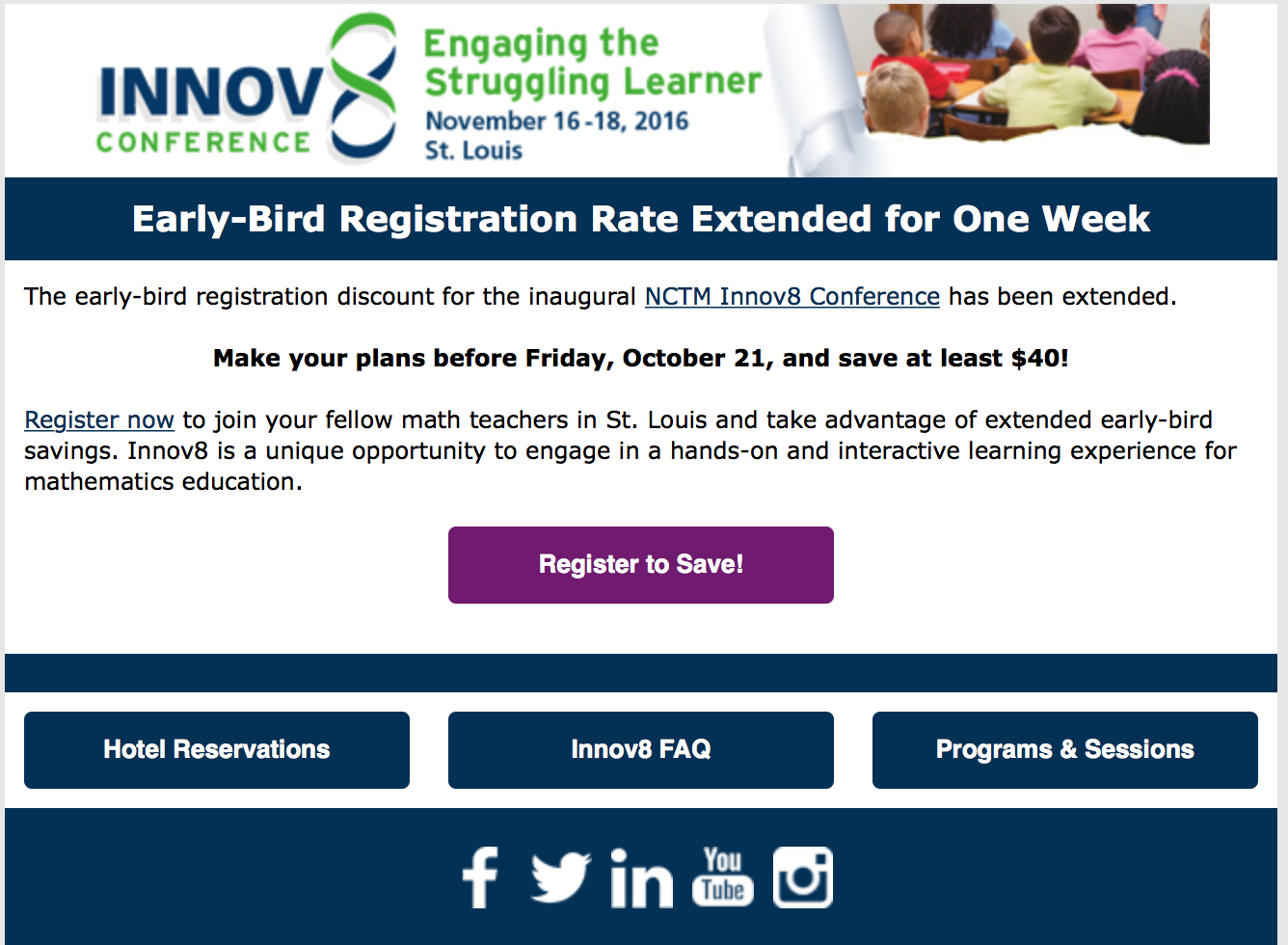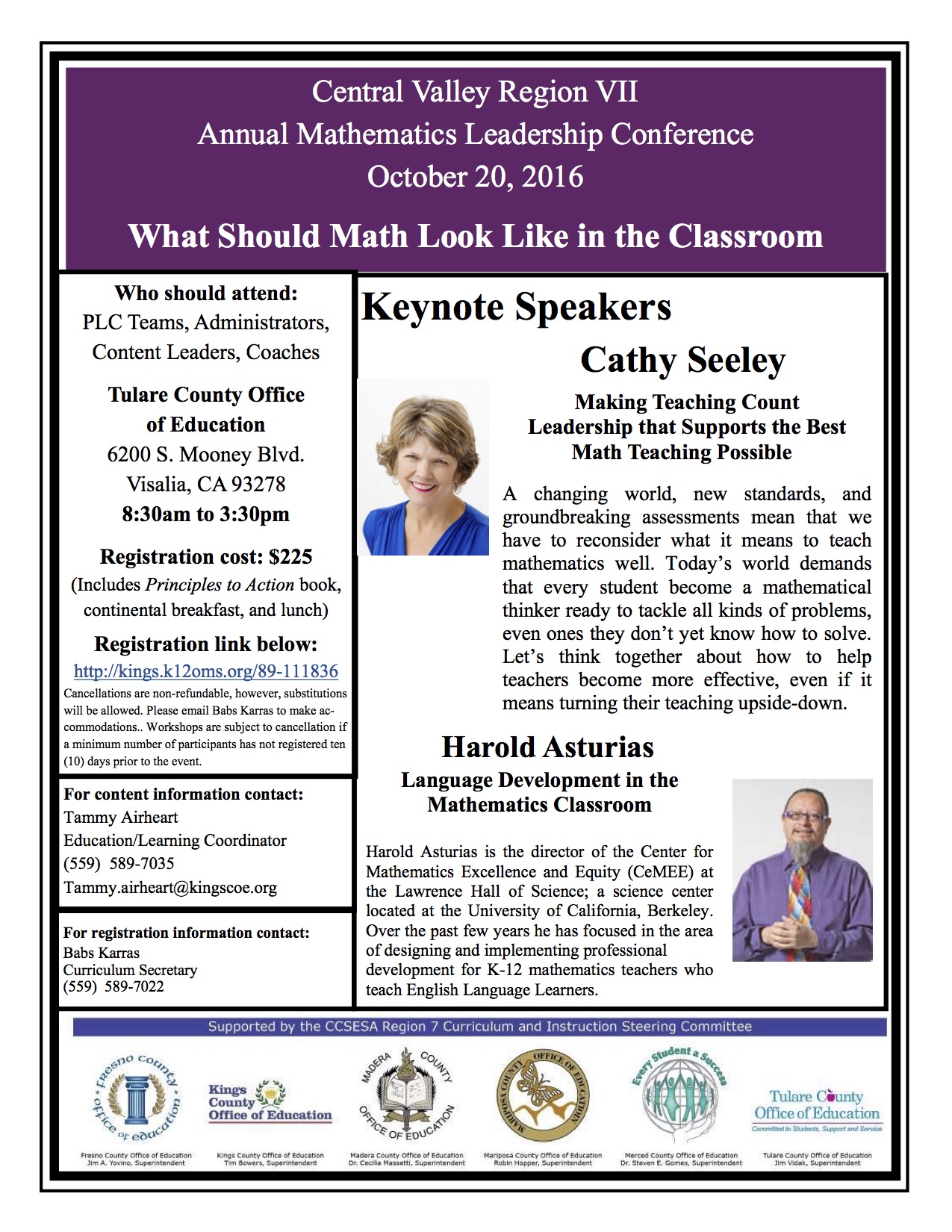Math Leadership Conference in Visalia
It’s Not Too Late to Register!
We are excited to welcome two outstanding mathematics leaders to the Central Valley Region 7 Annual Mathematics Leadership Conference on October 20, 2016 at Tulare County Office of Education. Please join us to hear Cathy Seeley and Harold Asturias as they help us understand what needs to take place in a mathematics classroom to help all students become powerful mathematical thinkers.
Cathy Seeley is a former president of NCTM and the author of several powerful books on effective mathematics instruction.
Harold Asturias is the Director of the Center for Mathematics Excellence and Equity (CeMEE) at the Lawrence Hall of Science and is devoted to helping teachers more effectively teach English Language Learners in the mathematics classroom.
Registration includes the book: Principles to Action. This is a great resource to use in your PLCs back at your site. See the attached flyer for the registration link and additional information.
The Six Living Generations In America
In America, there are six living generations, which are six fairly distinct groups of people. As a generalization each generation has different likes, dislikes, and attributes. They have had collective experiences as they aged and therefore have similar ideals. A person’s birth date may not always be indicative of their generational characteristics, but as a common group they have similarities.
The six living generations
GI Generation.
- Born 1901-1926.
- Children of the WWI generation & fighters in WWII & young in the Great Depression…all leading to strong models of teamwork to overcome and progress.
- Their Depression was The Great One; their war was The Big One; their prosperity was the legendary Happy Days.
- They saved the world and then built a nation.
- They are the assertive and energetic do’ers.
- Excellent team players.
- Community-minded.
- Strongly interested in personal morality and near-absolute standards of right and wrong.
- Strong sense of personal civic duty, which means they vote.
- Marriage is for life, divorce and having children out of wedlock were not accepted.
- Strong loyalty to jobs, groups, schools, etc.
- There was no “retirement” you worked until your died or couldn’t work anymore.
- The labor-union-spawning generation.
- “Use it up, fix it up, make it do, or do without.”
- Avoid debt…save and buy with cash.
- Age of radio and air flight; they were the generation that remembers life without airplanes, radio, and TV.
- Most of them grew up without modern conveniences like refrigerators, electricity and air conditioning.
- Sometimes called The Greatest Generation.

Mature/Silents.
- Born 1927- 1945.
- Went through their formative years during an era of suffocating conformity, but also during the postwar happiness: Peace! Jobs! Suburbs! Television! Rock ‘n Roll! Cars! Playboy Magazine!
- Korean and Vietnam War generation.
- The First Hopeful Drumbeats of Civil Rights!
- Pre-feminism women; women stayed home generally to raise children, if they worked it was only certain jobs like teacher, nurse or secretary.
- Men pledged loyalty to the corporation, once you got a job, you generally kept it for life.
- The richest, most free-spending retirees in history.
- Marriage is for life, divorce and having children out of wedlock were not accepted.
- In grade school, the gravest teacher complaints were about passing notes and chewing gum in class.
- They are avid readers, especially newspapers.
- “Retirement” means to sit in a rocking chair and live your final days in peace.
- The Big-Band/Swing music generation.
- Strong sense of trans-generational common values and near-absolute truths.
- Disciplined, self-sacrificing, & cautious.

Baby Boomers
- Born between 1946 and 1964. Two sub-sets:
- 1. the save-the-world revolutionaries of the ’60s and ’70s;
- and 2. the party-hardy career climbers (Yuppies) of the ’70s/’80s.
- The “me” generation.
- “Rock and roll” music generation.
- Ushered in the free love and societal “non-violent” protests which triggered violence.
- Self righteous & self-centered.
- Buy it now and use credit.
- Too busy for much neighborly involvement yet strong desires to reset or change the common values for the good of all.
- Even though their mothers were generally housewives, responsible for all child rearing, women of this generation began working outside the home in record numbers, thereby changing the entire nation as this was the first generation to have their own children raised in a two-income household where mom was not omnipresent.
- The first TV generation.
- The first divorce generation, where divorce was beginning to be accepted as a tolerable reality.
- Began accepting homosexuals.
- Optimistic, driven, team-oriented.
- Envision technology and innovation as requiring a learning process.
- Tend to be more positive about authority, hierarchal structure and tradition.
- One of the largest generations in history with 77 million people.
- Their aging will change America almost incomprehensibly; they are the first generation to use the word “retirement” to mean being able to enjoy life after the children have left home. Instead of sitting in a rocking chair, they go skydiving, exercise and take up hobbies, which increases their longevity.
- The American Youth Culture that began with them is now ending with them and their activism is beginning to re-emerge.

Generation X.
- Born between 1965 and 1980*
- The “latch-key kids” grew up street-smart but isolated, often with divorced or career-driven parents. Latch-Key came from the house key kids wore around their neck, because they would go home from school to an empty house.
- Entrepreneurial.
- Very individualistic.
- Government and big business mean little to them.
- Want to save the neighborhood, not the world
- Feel misunderstood by other generations
- Cynical of many major institutions, which failed their parents, or them, during their formative years and are therefore eager to make marriage work and “be there” for their children
- Don’t “feel” like a generation, but they are
- Raised in the transition phase of written based knowledge to digital knowledge archives; most remember being in school without computers and then after the introduction of computers in middle school or high school
- Desire a chance to learn, explore and make a contribution
- Tend to commit to self rather than an organization or specific career. This generation averages 7 career changes in their lifetime, it was not normal to work for a company for life, unlike previous generations.
- Society and thus individuals are envisioned as disposable.
- AIDS begins to spread and is first lethal infectious disease in the history of any culture on earth which was not subjected to any quarantine.
- Beginning obsession of individual rights prevailing over the common good, especially if it is applicable to any type of minority group.
- Raised by the career and money conscious Boomers amidst the societal disappointment over governmental authority and the Vietnam war.
- School problems were about drugs.
- Late to marry (after cohabitation) and quick to divorce…many single parents.
- Into labels and brand names.
- Want what they want and want it now but struggling to buy, and most are deeply in credit card debt.
- It is has been researched that they may be conversationally shallow because relating consists of shared time watching video movies, instead of previous generations.
- Short on loyalty & wary of commitment; all values are relative…must tolerate all peoples.
- Self-absorbed and suspicious of all organization.
- Survivors as individuals.
- Cautious, skeptical, unimpressed with authority, self-reliant.

Generation Y/Millennium.
- Born between 1981* and 2000*.
- Aka “The 9/11 Generation” “Echo Boomers” America’s next great generation brings a sharp departure from Generation X.
- They are nurtured by omnipresent parents, optimistic, and focused.
- Respect authority.
- Falling crime rates. Falling teen pregnancy rates. But with school safety problems; they have to live with the thought that they could be shot at school, they learned early that the world is not a safe place.
- They schedule everything.
- They feel enormous academic pressure.
- They feel like a generation and have great expectations for themselves.
- Prefer digital literacy as they grew up in a digital environment. Have never known a world without computers! They get all their information and most of their socialization from the Internet.
- Prefer to work in teams.
- With unlimited access to information tend to be assertive with strong views.
- Envision the world as a 24/7 place; want fast and immediate processing.
- They have been told over and over again that they are special, and they expect the world to treat them that way.
- They do not live to work, they prefer a more relaxed work environment with a lot of hand holding and accolades.

Generation Z/Boomlets.
- Born after 2001*
- In 2006 there were a record number of births in the US and 49% of those born were Hispanic, this will change the American melting pot in terms of behavior and culture. The number of births in 2006 far outnumbered the start of the baby boom generation, and they will easily be a larger generation.
- Since the early 1700’s the most common last name in the US was ‘Smith’ but not anymore, now it is Rodriguez.
- There are two age groups right now:
- (a) Tweens.
- (a1) Age 8-12 years old.
- (a2) There will be an estimated 29 million tweens by 2009.
- (a3) $51 billion is spent by tweens every year with an additional $170 billion spent by their parents and family members directly for them.
- (b)Toddler/Elementary school age.
- 61 percent of children 8-17 have televisions in their rooms.
- 35 percent have video games.
- 14 percent have a DVD player.
- 4 million will have their own cell phones. They have never known a world without computers and cell phones.
- Have Eco-fatigue: they are actually tired of hearing about the environment and the many ways we have to save it.
- With the advent of computers and web based learning, children leave behind toys at younger and younger age. It’s called KGOY-kids growing older younger, and many companies have suffered because of it, most recognizable is Mattel, the maker of Barbie dolls. In the 1990’s the average age of a child in their target market was 10 years old, and in 2000 it dropped to 3 years old. As children reach the age of four and five, old enough to play on the computer, they become less interested in toys and begin to desire electronics such as cell phones and video games.
- They are Savvy consumers and they know what they want and how to get it and they are over saturated with brands.
References.
deMesa, A. (2008). Marketing and tweens. Retrieved on February 21, 2008.
Elegant, S. (5 November 2007). China’s me generation. Time Magazine.
Generational Generalities. (2005). America’s generations. Retrieved November 6, 2007.
Generational Imperative. (2006). Meet Americas 5 living generations. Retrieved on November 6, 2007.
Marketing Vox. (2008). Generation Z. Retrieved on February 14, 2008.
Parents. (December 2007). Check out this news. Parents Magazine, p.166.
This is only a guideline, remember that everyone is different and not everyone fits into this analysis, but for the most part you can generalize their behavior. As a marketer, it is important to know how to effectively communicate and market to these diverse generations. In understanding consumer behavior, you can create the right promotion, tailoring it specifically for each group’s needs and therefore effectively sell products and services.
The dates for GI, Mature, and Baby Boomer and the beginning of Gen X are set and do not change, the dates for the end of Gen X, Gen Y and Gen Z fluctuate depending on what source you are using.
Passion In Education Joins Aims in New Podcasts
Goals, Purposes, and Plans for the AIMS Center Colloquium Series
In an attempt to provide opportunities for the Mathematics and Science teaching communities around the region to keep abreast of both the research that the AIMS Center for Math & Science Education, and the broader research community are finding, the Center will be putting on a series of “Colloquium” talks. These talks will be given by a variety of experts in the field: members of the Research Team of the AIMS Center, and other experts from around the country.
This year we have 16 sessions. Each session will take place on the 2nd and 4th Monday of each month from 4:30-6:00pm. All sessions will take place in theRichard Thiessen Conference Center at the AIMS Center for Math and Science Education located on the campus of Fresno Pacific University.
Upcoming Colloquia
| Date | Archive | Topic & Presenter |
| Aug. 22, 2016 | Video Archive | Constructivism Overview Richard Thiessen |
| Sep. 12, 2016 | Video Archive | Modeling in the Mathematics Classroom Chris Brownell |
| Sep. 26, 2016 | Using Technology to Facilitate Discussion Mike Fenton |
|
| Oct. 10, 2016 | Puzzles as Models of Thinking Richard Thiessen |
|
| Oct. 24, 2016 | Using “Discrepant Events” to drive learning in the Science classroom Steve Pauls |
|
| Nov. 14, 2016 | The Value of Productive Struggle Lori Hamada |
|
| Nov. 28, 2016 | Teaching Science for Greater Learning Jon Dueck, Jennifer Weibert |
|
| Jan. 9, 2017 | Professional Noticing: Attending AIMS Center Research Associates |
|
| Jan. 23, 2017 | Supporting Productive Struggle… Brandon Dorman, Meagan Dorman |
|
| Feb. 13, 2017 | Professional Noticing: Inferring AIMS Center Research Associates |
|
| Feb. 27, 2017 | Vertical Threads in Mathematics Carl Veater |
|
| Mar. 13, 2017 | Professional Noticing: Deciding AIMS Center Research Associates |
|
| Mar. 27, 2016 | The State of Math Education in the State Cathy Carroll |
|
| Apr. 10, 2017 | Teaching Mathematics for Social Justice… Manjula Joseph |
|
| Apr. 24, 2017 | The Implications of Neuroscience on Learning Richard Thiessen, Mel Riccardi, Steve Pauls |
|
| May 8, 2017 | Literature Connections Jon Dueck |
For those unable to attend in person, a virtual option will be provided. Information for accessing the talk virtually will be posted on the home page a few days prior to the event.
CLEAN STORMWATER GRANTS
Clean Stormwater Grants
The 2017 Clean Stormwater Grants are now available. Go to the Fresno Metropolitan Flood Control District’s website, http://www.fresnofloodcontrol.org/clean-storm-water-program/community-assistance/clean-storm-water-grants/# for all the details and to download an application.
The grants available are:
· Clean Stormwater Grant for water resources field trips; environmental restoration, enhancement and preservation; stormwater quality information and education; household hazardous waste information and education; business stormwater pollution prevention assistance and education; and environmental assessment projects. Grants up to $2,000.
· Clean Stormwater Grant – High Priority Requested Grant Projects for a San Joaquin River clean-up project or a low impact development demonstration project. Grants up to $4,000.
· 5th Grade Field Trips to Scout Island to take your 5th grade classes (or other grade levels) to the San Joaquin River for a field trip with Scout Island docents. Grant pays for Scout Island and the transportation.
Water Resource Education Program
Fresno Metropolitan Flood Control District staff is available to come to your classroom or business to provide an educational presentation about local water resources, our watershed and pollution prevention. Contact Patrick Bryan at (559) 456-3292 or patrickb@fresnofloodcontrol.org to schedule a presentation.
Earth Sciences Local Water Resources Classroom Tools
Fresno Metropolitan Flood Control District offers free educational materials for schools and organizations. Materials available include infographics, posters and PowerPoint presentation for 6th – 8th grade students; an activity book for 1st – 3rd grade students; Fresno the Mountains to the Valley activity book for 4th – 6th grade students; Storm Drains 101 DVD; local water cycle poster and more. Go to our website at http://www.fresnofloodcontrol.org/educational-materials/ to order materials.
To keep up to date follow us on Facebook at https://www.facebook.com/pages/Fresno-Metropolitan-Flood-Control-District/231056563609284.
If you have any questions please contact me at the email address or phone number below.
Thank you.
Kristine Johnson
Senior Staff Analyst, Environmental Dept.
Fresno Metropolitan Flood Control District
5469 E. Olive Avenue
Fresno, CA 93727
(559) 456-3292, Fax (559) 456-3194
My Child Is Going to College!
Are you looking for what to say and what to think as you send your child off to college? How is this as hard as sending your child to kindergarten? Here are a few words that might help you. Share it and check the links out as well. This is a big move for your child going to college. I have been there and my heart goes out to all you moms! ~Sandy
College is a Privilege
Sure, I expected you to go and, in turn, you expected nothing less from yourself. But this in no way takes away from the fact that spending these years learning, growing and focused almost exclusively on yourself is a gift like none other. Think through the sweep of human history and try to guess how many people were given this opportunity. Only after you have acknowledged just how rare and special this gift is, will you respect this opportunity.
Best Years of Your Life
You have heard adults say it a hundred times and it may be true, but it is not automatically so. Imbibe deeply of all that a university has to offer. Heap your plate with its academic, athletic, cultural and social offerings. Never again will life mix youth, freedom, opportunity and resources together in quite this heady combination. If these are to be the very best years, you must make them so.
College is a Time like None Other
Everyone will want to meet you and there will be none of the social awkwardness that usually accompanies rushing up and speaking to total strangers. Do not squander this short window of opportunity, it will never come around again.
Drinking Dilemma
You are now in a place where alcohol is both tacitly allowed and legally forbidden. The only thing that stands between you and a very bad experience is your own good judgment. But here is the tricky part. You need to exercise that good judgment at the very moment when it is already impaired by alcohol.
Being Friends in High School was Easy
You sat in the same classes or did the same activities as your high school friends. In college, maintaining friendships is a bit more work. After college it is a lot more work. Investing in friendships now pays dividends forever, truly forever.
Living With Those Who Love You
It is your good fortune to never have lived in a place where no one loved you or frankly cared about you. At the outset, college is that place. Despite everyone’s outward cheer in the first weeks of college you will have no real friends. Sure you will know some kids, but these are not true friends, yet. They are still just acquaintances you really like. It is better to live amongst those you love, but it takes time and only you can make this happen.
Do Not Fool Yourself, I Was 18
When you look at me you probably see “Mom” and “Old.” Do not fool yourself. Not one fiber of my being has forgotten how it feels to be 18. If you have a problem, talk to me. Few things you will say will shock me and there is every chance, though admittedly just a chance, that I might have a good suggestion. And while the law may recognize you as an adult, I promise you that you still have much to learn.
I have loved you every moment of your life. Even as you prepare to move out, I shock myself by loving you even more. This love comes without strings, but life does not. If there are things you want to achieve, knowledge you want to gain, friends you want to make it is now entirely up to you.
http://grownandflown.com/
New California Science Framework
State Schools Chief Tom Torlakson Invites Public Comment on Draft California Science Framework
SACRAMENTO-California is taking a step forward in updating its science curriculum by gathering public comment on a new framework, State Superintendent of Public Instruction Tom Torlakson announced today.
The Science Framework for California Public Schools: Kindergarten Through Grade Twelve (CA Science Framework) will provide guidance for teachers, administrators, and parents on how a curriculum based on content standards is implemented in the classroom. This new draft framework provides guidance on how to integrate the Next Generation Science Standards for California Public Schools: Kindergarten Through Grade Twelve (CA NGSS) and the California English Language Arts and Literacy Standards and the California English Language Development Standards in the science classroom. The CA Science Framework will provide direction for the development of instructional materials, curriculum, instruction, assessment, and professional learning.
The draft CA Science Framework includes narrative course descriptions for transitional kindergarten through grade twelve as well as chapters on assessment, access and equity, and supporting high-quality science instruction. It provides direction to educators to implement state standards in the context of California’s diversity and helps them teach the critical thinking skills students will need for 21st century careers.
The draft framework has been posted on the California Department of Education Science Curriculum Frameworks Web page. Members of the public may send comments on the draft CA Science Framework directly by e-mail to scienceframework@cde.ca.gov. The current comment period will remain open until August 29, 2016. All public comments received during the field review survey will be presented to the Instructional Quality Commission and the State Board of Education for review and possible inclusion into the final CA Science Framework. The Board is scheduled to take final action on the document by November 2016.
For more information on the development of the draft framework, visit the California Department of Education Science Curriculum Frameworks Web page.
You Are Supposed to Struggle
The butterfly is SUPPOSED to struggle. In fact, the butterfly’s struggle to push its way through the tiny opening of the cocoon pushes the fluid out of its body and into its wings. Without the struggle, the butterfly would never, ever fly. As you go through school, and life, keep in mind that struggling is an important part of any growth experience. In fact, it is the struggle that causes you to develop your ability to fly.”
From Caterpillar to Butterfly
Think about the caterpillar morphing into the butterfly, a beautiful analogy for change in the spiritual sense. We all feel like a caterpillar at times, an ugly, undeveloped self (I personally don’t think caterpillars are ugly, I think they’re kinda cute in their pudgy way!). We all want to be the butterfly, the gorgeous finished product, flying about in grace and beauty, experiencing bliss everywhere we go. We all want to be seen as beautiful, respectable, and lovely. How do we get to that? It isn’t so easy, some would say.
We see people who have become the finished product, a successful, beautiful, powerful human being who has it all together. We all see people who we respect, admire and wish we were like, right? However, those people did not come into it without a lot of work on themselves spiritually, emotionally, mentally and physically.
We all want to be the butterfly, but do we really want to go through the process that it takes to become that? There is a molting period, a liquification of self that is part of that process of going from the form of caterpillar to butterfly. It doesn’t necessarily look like a pleasant process, morphing into another form. Literally there has to be a breakdown of the first form, a dissecting or dissolution process, and then there is room in reality for the new form to be born.
It is a death and birth process, and both of those processes tend to be messy, dramatic, and difficult in their own respects. When you do both together, it gets even messier and more difficult! Death and rebirth at the same time are a superb event indeed.
Think about what you see in yourself as the caterpillar, the undeveloped and “first form” type of self. You might be all caterpillar in your opinion, or some percentage of caterpillar versus a percentage of butterfly. Perhaps you’ve been working on yourself for quite a while and you already transformed some parts of yourself that were “ugly” or undeveloped before now. Perhaps you feel like you might even be getting close to being a butterfly. Just examine where you think you are in the morphing process of the death of the old self and the birth of the new self.
Truly, the new self was always there, just as the butterfly was always there in the caterpillar. It isn’t visible before the transformation, but the blueprint and the potential was always there and present. I think of the new self as the eternal, deeper self, the You that was always present, even as the idea of yourself as a human seemed to take precedence for a while in the first part of your life.
The eternal self that you are is the butterfly, and it was always there. It isn’t born or created, it is only the idea of being a human version of self as the sole identity, the caterpillar, that needed to be liquefied and disintegrated. Then the already present butterfly underneath the illusion can emerge from the cocoon of change.
What is your version of the cocoon? What is your version of the cauldron or catalyst for change? How is it that you are disintegrating the idea that you are just a human, mortal self with a specific name and identity? How are you molting into the new form, seeing yourself as immortal and eternal self? How are you becoming aware that you are consciousness dreaming itself to be a specific human with a certain collection of experiences? Your cocoon of change is unique to you, and you are inside it, searching, seeking, and spiritually growing.
I would encourage you to simply stop and be the butterfly that you already are. Stop all the figuring, strategizing, fixing of yourself, and all the searching. You are already what you want to become. All you have to do is literally “drop” the old form, the old ideas of self and step out of who you think you are for just a moment. It is only a matter of readjusting your perceptions of who you think you are in the journey between caterpillar to butterfly.
It doesn’t actually take work or effort on your part to become the new self. The caterpillar does not “work” to become the butterfly. It doesn’t “do” anything! It simply waits for the old form to drop away, being patient while the discomfort of dissolution happens, if it is uncomfortable at all. Maybe it’s not.
Maybe it is us who makes the morphing process so difficult. We are so mind focused as a species and it might well be ourselves who are interfering with how easy the process of letting go of the old form. We can simply let it fall away, but in our own minds we find that hard to be at ease with. We have to make it hard and uncomfortable, for some reason.
Discomfort and difficulty might not be the nature of the process of transformation at all. Perhaps the period of transition from caterpillar to butterfly is not that difficult. Perhaps it is a state of bliss and relaxation for the caterpillar as it becomes the butterfly.
I encourage you to look at how you might be interfering with your own process of transformation from the old self to the new self. Perhaps it would be so much easier if you just rest your mind, don’t try to fix anything, and simply be present in the moment in a relaxed state of mind, patient with the process of the old falling away and the new showing up. It doesn’t have to happen overnight, and perhaps that is where much of your dissatisfaction with the process is coming from. You want the butterfly to be in full flight already, but there is a period of dissolution and resolution still happening. You can’t rush that process.
Be patient. The butterfly-you is present and already perfect, already formed. All you have to do is relax, drop the old stories and identities, and simply let your eternal nature emerge. It is actually very simple. Sure, some of your old caterpillar ways might reappear and assert themselves now and then, but you can always redirect your awareness back into the butterfly-you at any and all times.
You could think of the human condition as the caterpillar, and the eternal self that you are as the butterfly. Both exist, both have form in the same lifetime, and you are able to switch back and forth between both of those forms. The goal is to rest in the butterfly version of self more often than you might now, but that comes. It is a lifelong goal, a lifelong period of readjustment.
Be at peace. You do not have to fix everything in your personality. That all becomes “fixed” automatically when you shift your point of view into that of the eternal self rather than that of the struggling human. You do not have to find anything that you don’t know about already, it is all there inside you. It is innate knowing within you. All you must do is relax and let the butterfly come forth. It is already here, present and completely whole. Simply drop the old forms and ideas, the old ways of being, and the new you is already here, fully functional and present.
7 types of ADHD – Dr. Amen
Do any of these sound like you or your children? My son showed highly probable in 7 of the 7 at Dr. Amen’s Clinic. Poor guy! Below shows possible treatments. ~Sandy
Are There Really 7 Types of ADD?
Controversy surrounds Dr. Daniel Amen’s 7 types of ADD — each with its own unique ADHD symptoms, brain function, and neurotransmitter activity. What do you think of his theories and methodologies?
Classic ADD
Treating Classic ADD
Inattentive ADD
Treating Inattentive ADD
Over-Focused ADD
Over-Focused ADD
Temporal Lobe ADD
Treating Temporal Lobe ADD
Limbic ADD
Treating Limbic ADD
Ring of Fire ADD
Treating Ring of Fire ADD
Anxious ADD
Treating Anxious ADD
For More Information:
Learn more about the 7 Types of ADD:
- Listen to Dr. Amen’s podcast on the 7 Types of ADD
- Watch Dr. Amen’s TEDx talk on SPECT imaging
- Read one of Dr. Amen’s 30 books including The Daniel Plan,Change Your Brain, Change Your Life, Magnificent Mind at Any Age, and Healing ADD.
Trade School vs. College
Many realize that not everyone is created to go to college. What are your talents? Gifts? Skills? What is your passion? Take that route! ~Sandy
Why You Should Consider Trade School Instead of College
For a lot of people, going to a four-year college seems like an automatic choice when they graduate from high school. The reason is obvious – higher income. According to theNational Center for Educational Statistics, a bachelor’s degree accounted for an average of $16,900 in additional income per year compared to a high school diploma ($30,000 versus $46,900).
Over a 30-year career in the workforce, that’s more than a $500,000 difference in earnings. These numbers may not paint the whole picture, however. Due to the increasingly high costs associated with a college education, as well as other drawbacks, more and more people have been considering trade school as an education alternative. If you’re one of them, you can actually search for a great trade school right here using the tool below:
Find Schools That Fit YouThree easy steps and we’ll connect you to our online education partner that matches your needs.
Trade School vs. College: Drawbacks to College Education
Length: Four (or More) Years vs. Two Years
For starters, a bachelor’s degree typically takes four years of study, which means that people who enter the workforce after receiving their bachelor’s degree aren’t doing so until age 22. That shaves some years off of a person’s career and can be considered an opportunity cost for experiencing the ‘real world’ hands on instead of being in a classroom. Plus, a four-year program usually makes you take classes outside of your major to fulfill credit requirements. Unless you enjoy spending time in a classroom, it may seem unnecessary to pay for extraneous credits and courses. Sure, that improv theater class was fun, but was it helpful for your chemistry major?
High Cost of a Bachelor’s Degree
Another drawback is the cost. Research conducted by the Idaho Department of Laborfound that the average bachelor’s degree in the United States costs $127,000! Not only that, but nearly 70% of students take out loans to help pay for school. According to the study, over 20% of students with loans owe more than $50,000, and 5.6% owe more than $100,000 at the end. Although some student loans are certainly better than others, the added cost of accruing interest makes the overall expense of receiving an education in the U.S. significantly higher for the average student than the already steep price tag suggests. The college lifestyle isn’t cheap either — dorming, paying for food, going out, and even doing your own laundry adds up!
Dropout Rate + Late Grads
A third drawback: Some people simply aren’t prepared for the rigors of a four-year college. For many students, college is their first experience away from home and, without an adequate plan, it’s easy to stray off course. In fact, the Institute of Education Statisticsestimates that 40% of attendees at a four-year college drop out before completing their degree. If you find yourself as a part of that 40%, not only have you incurred some of the expense of college, you left without receiving a degree. For the 60% that do complete their degree, a whopping 64% take longer than four years to graduate, costing themselves nearly $70,000 in lost wages and educational expenses per year, according toU.S. News. Most colleges don’t even require students to pick a major until the end of their sophomore year, creating a class of undecided students who may have wasted their time and credits on courses that they chose not to pursue.
Poor Economic Conditions
Finally: Job prospects for new graduates may not be as bright as they had expected. Although some college majors are faring better than others when it comes to labor market outcomes, a recent report released by the Economic Policy Institute states that overall, the unemployment (8.5%) and underemployment (16.8%) rates for college graduates under the age of 25 are nearly double what they were in 2007. Over the past five years, graduates have faced sluggish labor markets Young graduates are faced with limited job opportunities and difficulty paying off their student loans. College degrees are a career investment that require a considerable amount of both time and money, and the portion of grads who are unable to find desirable employment (or employment at all!) are seeing negative returns.
Trade School as an Alternative
My response to these statistics is that people approaching high school graduation should seriously consider trade school, particularly if they are not at the top of their class. A traditional four-year degree is not for everyone, and trade school offers a pretty compelling career path, especially when considering the factors associated with a college education outlined above. I’ll provide an overview of what a trade school education is, who it would be best for, and some of the advantages of trade school versus college.
What is a Trade School or Vocational School?
A trade school, also known as a technical or vocational school, is an educational institution that exists to teach skills related to a specific job. Trade schools are a more streamlined approach to education, with curricula focusing on developing a particular skillset and knowledge base for a career rather than receiving a general education. Trade schools typically take a lot less time to complete, have smaller class sizes, and the majority of the training is hands-on, which is an ideal environment for many types of learners. Vocational degrees can lead to well-paying jobs like electrician, mechanic, machinist, pharmacy technician, nuclear technician, and dental hygienist, with room for growth and managerial potential in each field.
Advantages to Trade Schools
Salaries for Trade School Jobs
For starters, salaries for trade school graduates aren’t that much of a drop-off compared to a four-year degree. According to the National Center for Educational Statistics, technical and trade school jobs have a median annual salary of $35,720, though this figure varies heavily based on the particular industry and the experience level of the worker. The BLS predicted earnings for bachelor’s degree holders to be roughly $46,900, amounting to an annual difference of $11,180. This stat, of course, doesn’t factor in long term earnings growth.
However, because trade school only takes an average of two years to complete versus four, that amounts to an additional two years of income for the trade school graduate, or $71,440. Factor in another $70,000 in costs for the many students who take an extra year to graduate from college, and trade school grads can be over $140,000 ahead at the get-go, making up for over 12 years of difference in income.
Price of Education
The average trade school degree costs $33,000, which, compared to a $127,000 bachelor’s degree, means a savings of $94,000. But that’s not all! If you assume that students are fully financing their education with loans at 4% over 10 years, the bachelor’s degree will cost $154,000, while the trade school degree will cost only $40,000. That’s a savings of $114,000 just on the degree.
Of course, most students in both cases won’t fully finance their education. They’ll work and find other sources of income to help with the process, meaning the gap will be smaller in the average case. Research gathered in 2012 suggests that the average college student debt load is $29,900, and that number rises to $36,327 when factoring in interest. Conversely, the average debt load for students graduating from a two-year technical school is $10,000, roughly 70% less than the four-year graduate.
Job Security
Yet another advantage of technical trade school is that most of the jobs you’ll get are extremely difficult to export to another country. More and more jobs are being outsourced to places where labor is cheaper, making domestic employment in certain sectors difficult to get. It is much easier to export, say, computer programming work or other information economy work than it is to export carpentry or electrical work, as that requires a physical presence.
Not only that, but there’s a growing domestic demand for high-precision skills. According to Forbes, skilled trade workers are a disproportionately older population, and will only continue to get older, creating increased opportunities for young workers to fill their shoes.
Final Thoughts on Trade School vs. College
It should be noted that I’m not opposed to a four-year degree; instead, I’m simply making a strong case for an option that many people overlook when deciding what to do after high school. In lifetime earnings, a bachelor’s degree still pays off – don’t get me wrong. According to statistics, a person with a bachelor’s degree is projected to earn around $1.1 million, compared to the $393,000 projected earnings of an associate’s degree or trade school program graduate.
The advantages of a four-year degree are many: You’re going to earn much more later on in life and you also have the door wide open to continue your studies and earn substantially more with a masters degree or doctorate, however the cost/benefit equation to even higher education is changing every day.
Trade school graduates are very limited in opportunities to continue to bolster their education. That being said, a four-year degree is expensive, and not suited to everyone’s learning style and skill set. If you’re a hands-on learner, excited by the prospects of getting out of the classroom and starting to work immediately after high school, trade school is a relatively inexpensive alternative education that may work well for you. Take advantage of the search tool above to learn more about trade schools near you and what they offer.
I’ll leave you with an anecdote. My wife’s cousin graduated from high school at roughly the same time my wife graduated. Her cousin went to electrician’s school, while my wife went to four-year university. Her cousin started working three years before my wife and incurred much less student loan debt. Today, though he makes a little bit less money than she does, the difference isn’t very significant, plus he had hardly any debt to pay off after school.
This past May, my nephew graduated from high school. He is now attending electrician’s school as well. I think it’s the wisest move he could have made in his situation.
If you are graduating from high school soon, or have a loved one who is approaching graduation, I recommend seriously considering trade school as an alternative option. If you’re still unsure about your academic future or you’re looking for more information and options, check out our education series.





